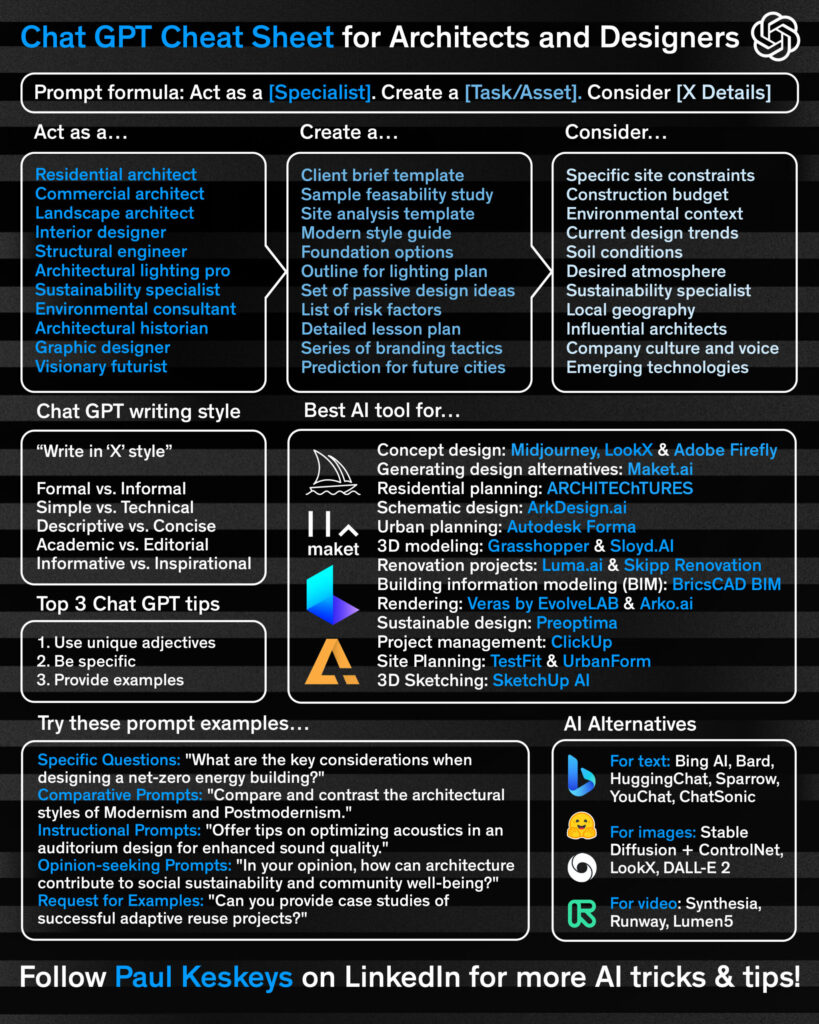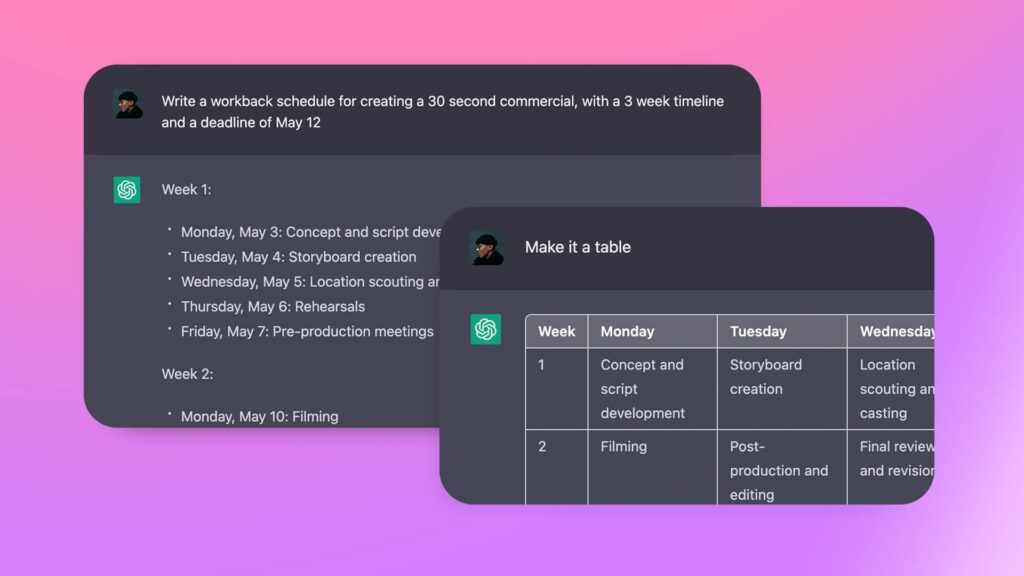Discover a world of creativity and innovation with the “Top ChatGPT Prompts for Architects.” Uncover the power of ChatGPT, an AI-driven language model that is revolutionizing the architectural landscape. This blog post will guide you through the endless possibilities of ChatGPT, specifically tailored for architects. Fuel your imagination, foster forward-thinking, and enhance your design journey with architecture-specific prompts. Join us as we dive into the exciting realm of architecture ChatGPT prompts.

Introduction
Welcome to an exploration of the revolutionary power of ChatGPT in the field of architecture. In this article, we will dive deep into the realm of ChatGPT, an AI-driven language model that is transforming the architectural landscape. With a focus on architecture-specific prompts, we aim to inspire creativity, foster collaboration, and streamline the design process for architects, designers, and enthusiasts alike.
1. What is ChatGPT?
1.1 Understanding ChatGPT
ChatGPT stands for Chat Generative Pre-trained Transformer, a language model developed by OpenAI. This cutting-edge AI technology has the ability to generate human-like text responses based on a given prompt. By leveraging a large dataset of text from the internet, ChatGPT has been trained to understand and mimic human conversation, making it a valuable tool for architects seeking innovative ideas and solutions.
1.2 How ChatGPT works
At its core, ChatGPT is built upon the Transformer architecture, which enables it to process and generate text in a hierarchical manner. It employs a mechanism called attention, which allows it to understand relationships between words and phrases, giving it the ability to generate coherent and contextually relevant responses. By fine-tuning the model on specific prompts, architects can harness the power of ChatGPT to generate unique insights and design concepts.
1.3 Importance of ChatGPT in architecture
ChatGPT has emerged as a game-changer in the field of architecture. It empowers architects by providing a new method of ideation and collaboration. By leveraging the vast knowledge and creativity of ChatGPT, architects can push the boundaries of design and explore innovative solutions to complex architectural challenges. ChatGPT opens up a world of possibilities, helping architects bridge the gap between imagination and reality.

2. Benefits of ChatGPT for Architects
2.1 Enhanced creativity and idea generation
One of the key benefits of ChatGPT for architects is its ability to enhance creativity and idea generation. By interacting with ChatGPT, architects can tap into a vast repository of knowledge and inspiration, stimulating their creative thinking process. With the ability to generate unique and out-of-the-box design concepts, ChatGPT becomes a valuable tool for architects looking to push the boundaries of traditional design.
2.2 Collaboration and interaction
ChatGPT also facilitates collaboration and interaction among architects. Through its conversational interface, architects can engage with ChatGPT in a dynamic manner, bouncing ideas off the model and receiving real-time feedback. This collaborative process fosters a sense of partnership between the architect and the AI model, fueling creative exchanges and leading to new and exciting design possibilities.
2.3 Simplified design process
Another advantage of using ChatGPT in architecture is its potential to simplify the design process. By providing instant responses and suggestions, ChatGPT can help streamline the conceptualization and refinement stages of architectural design. Architects can rely on ChatGPT as a virtual design assistant, accelerating the decision-making process and ensuring efficiency in their design workflow.
3. Selecting the Right Prompt
3.1 Generating accurate architectural responses
When engaging with ChatGPT, it is crucial to select the right prompt. Architects should formulate prompts that clearly articulate the desired architectural objectives and constraints. This ensures that ChatGPT generates accurate and relevant architectural responses. By providing specific details, such as building type, style, and functionality, architects can guide ChatGPT to produce more tailored and viable design suggestions.
3.2 Considering the scope and complexity of prompts
Architects must also consider the scope and complexity of the prompts they use with ChatGPT. If the prompt is too broad or open-ended, the model may struggle to provide precise and actionable insights. On the other hand, overly specific prompts may limit the model’s creativity and potential for unconventional design ideas. It is essential to strike the right balance and experiment with different prompt formulations to achieve optimal results.
3.3 Incorporating architectural terminology
To maximize the effectiveness of ChatGPT in architectural conversations, it is advisable to incorporate relevant architectural terminology into prompts. By using industry-specific terms, architects can ensure that ChatGPT understands and responds in a way that aligns with architectural principles. This helps maintain the integrity of architectural discourse and fosters a more meaningful exchange of ideas between the architect and the AI model.

4. Popular ChatGPT Prompts for Architects
4.1 Prompt 1: Design a sustainable eco-resort
One popular prompt architects can use with ChatGPT is to design a sustainable eco-resort. By providing specific criteria related to sustainability, materials, and energy efficiency, architects can harness ChatGPT’s creative capabilities to generate unique and environmentally friendly design concepts. This prompt encourages architects to explore innovative solutions that merge luxury with ecological responsibility.
4.2 Prompt 2: Create a futuristic skyscraper
For architects looking to push the boundaries of architectural design, a prompt asking ChatGPT to create a futuristic skyscraper can lead to exciting possibilities. By specifying the desired aesthetic, functionality, and sustainability features, architects can engage in a dialogue with ChatGPT, generating cutting-edge design ideas that challenge traditional notions of skyscraper architecture.
4.3 Prompt 3: Revamp an abandoned industrial site
Another compelling prompt to explore with ChatGPT is the revamping of an abandoned industrial site. Architects can provide details about the site’s history, context, and intended use, allowing ChatGPT to suggest imaginative design solutions that breathe new life into neglected urban landscapes. This prompt encourages architects to reimagine the potential of existing spaces and promote urban regeneration.
4.4 Prompt 4: Design an innovative museum
Architects passionate about cultural and educational spaces can prompt ChatGPT to design an innovative museum. By specifying the museum’s theme, visitor experience, and architectural features, architects can tap into ChatGPT’s vast knowledge base to generate captivating and immersive design concepts. This prompt challenges architects to create spaces that engage, educate, and inspire visitors.
5. Using ChatGPT in Different Design Stages
5.1 Conceptualization and ideation
ChatGPT proves immensely valuable during the conceptualization and ideation stages of architectural design. Architects can engage in a dialogue with ChatGPT, exploring various design possibilities, testing out ideas, and receiving instant feedback. This iterative process helps refine initial concepts and uncover new insights, making the ideation phase more dynamic and efficient.
5.2 Feasibility and viability analysis
As architects move towards the feasibility and viability analysis of their designs, ChatGPT can provide valuable input. By asking specific questions related to structural integrity, material selection, or construction techniques, architects can receive insights that help validate their design decisions. ChatGPT acts as a virtual collaborator, contributing to the rigorous analysis and evaluation of architectural designs.
5.3 Detailing and refinement
During the detailing and refinement stages, ChatGPT serves as a valuable tool for architects. By asking for suggestions regarding interior layouts, material finishes, or lighting strategies, architects can access ChatGPT’s creative expertise. This interactive process helps architects uncover design solutions they may not have considered, ultimately contributing to the overall refinement and polish of their architectural projects.

6. Challenges and Limitations of ChatGPT in Architecture
6.1 Lack of contextual understanding
One of the key challenges of using ChatGPT in architecture is its potential lack of contextual understanding. While ChatGPT can generate coherent text responses, it may struggle to grasp the full context and nuances of architectural design. Architects must remain mindful of this limitation and exercise critical judgment when interpreting and implementing ChatGPT’s suggestions.
6.2 Overreliance on existing information
Another limitation to consider is the risk of overreliance on existing architectural information within ChatGPT’s training dataset. While the model has been trained on a vast amount of text, it is essential to verify and cross-reference any information generated by ChatGPT with reliable sources. Architects should approach the output with a critical eye, ensuring that it aligns with their professional knowledge and expertise.
6.3 Generating technically accurate solutions
For architects dealing with complex technical challenges, ChatGPT’s ability to generate technically accurate solutions may vary. As ChatGPT is a language model trained on textual data, it may not possess the same level of technical expertise as experienced architects or engineers. While it can provide valuable insights, architects should complement ChatGPT’s suggestions with specialist knowledge to ensure the feasibility and safety of their designs.
7. Ethical Considerations
7.1 AI responsible design practices
Incorporating AI into architecture raises important ethical considerations. Architects utilizing ChatGPT must employ responsible design practices. This includes attributing appropriate credit to the AI tool, conducting thorough due diligence on the generated information, and considering the potential impact of AI-driven designs on society and the environment. Architects have a responsibility to ensure that AI is used ethically and that its integration into the design process benefits all stakeholders.
7.2 Addressing bias and inclusivity
Architects must also be mindful of potential biases that may manifest in the AI-generated responses from ChatGPT. Bias can inadvertently perpetuate societal imbalances or exclude marginalized communities. Architects should actively work to challenge and rectify any biased outputs, promoting inclusivity and diversity in their design process. By recognizing the limitations and biases of AI, architects can strive for a more equitable and inclusive built environment.

8. Best Practices for Architects Using ChatGPT
8.1 Phrase prompts effectively
To optimize the interaction with ChatGPT, architects should learn to phrase prompts effectively. Clear instructions and well-defined parameters help guide ChatGPT’s responses towards the desired outcomes. Architects should experiment with different prompt formulations, refining their prompts over time to enhance the quality and relevance of the generated architectural insights.
8.2 Experiment with different constraints
Architects should embrace the flexibility of ChatGPT and experiment with different constraints. By providing constraints related to space, materials, or sustainability, architects can explore various design options within specific boundaries. This deliberate exploration of constraints helps stimulate creative thinking and expands the possibilities of architectural design.
8.3 Collaborate with other architects and AI experts
To fully harness the potential of ChatGPT, architects should actively seek collaborations with other professionals in the field. By working with AI experts and fellow architects, a collective knowledge base can be developed to enhance the chatbot’s intelligence and relevance in architectural contexts. Collaborative efforts ensure that the implementation of ChatGPT aligns with the specific needs and challenges faced by architects.
10. Future possibilities and Potential Enhancements
10.1 Customizable prompts for specific architectural styles
As ChatGPT continues to evolve, architects may look forward to the development of customizable prompts for specific architectural styles. This enhancement would allow architects to fine-tune the model’s responses according to the principles and characteristics of various architectural movements. By incorporating style-specific prompts, architects can leverage ChatGPT’s creative capabilities while maintaining stylistic integrity in their designs.
10.2 Integration with architectural software
The integration of ChatGPT with architectural software holds great promise for the future. By seamlessly connecting ChatGPT with software platforms used in architectural design, architects can leverage the AI model’s insights in real-time. This integration can enhance the overall design workflow, enabling architects to receive instantaneous feedback and suggestions as they work on their architectural projects.
10.3 Real-time collaboration with AI models
Looking ahead, real-time collaboration with AI models could become a reality. By incorporating ChatGPT into virtual reality or augmented reality environments, architects could engage in immersive architectural design processes. Such collaboration would enable architects to interact with AI models in real-time, visualizing and fine-tuning their designs in an interactive and dynamic manner.
In conclusion, ChatGPT presents a paradigm shift in the field of architecture, reshaping the design journey for architects worldwide. With its ability to enhance creativity, foster collaboration, and streamline the design process, ChatGPT holds immense potential for architects seeking to explore innovative design solutions. By understanding the best practices, limitations, and ethical considerations, architects can effectively leverage ChatGPT to unlock new dimensions of architectural design. Join us on this exciting journey as we unleash the power of ChatGPT in architecture and shape the future of the built environment!


